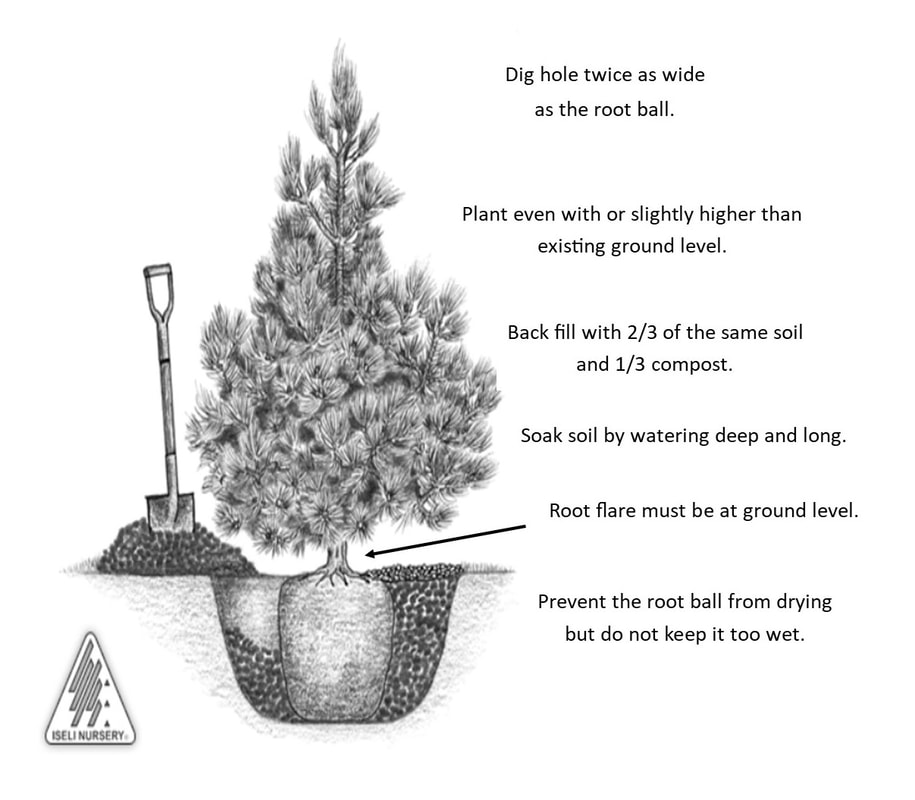PLANTING INSTRUCTIONS
The most common mistake in tree and shrub planting is planting the rootball too deep or too high. To avoid this, begin by locating where the trunk flare begins. Soil may have been pushed up over the trunk flare due to digging to bottom of the rootball. This will give the measurement for the depth of the hole. Dig the hole 1-2" less than this measurement to insure that the truck flare will be slightly above the grade level. The width of the hole should be 2-3 times wider than the size of the rootball.
So, in general, the hole should be twice as wide and just as deep as the rootball.
Carefully set the plant in the hole making sure the rootball rests on fir undisturbed soil. When the plant is properly set, remove the string and cut the burlap off down to the top of the wire cage. If possible, remove the top third or half of the wire cage. This can be accomplished with bolt or wire cutters. If rootball is in danger of falling apart leave wire basket intact.
When back filling around the tree or shrub use the existing soil. if the soil is in poor condition, use 2/3 existing soil and mix 1/3 of compost or planting mix. When hole is filled, tamp down gently to remove any air pockets. Air pockets also may be removed by watering the soil halfway through backfill process and allowing it to drain. Smooth the surface of woil, making sure the trunk flare is exposed and the rootball is not covered with soil. Build a saucer near edge of hole to retain water. This will allow water to soak down to the roots and avoid water runoff. The saucer should be removed before the ground freezes. This keeps water pooling in the saucer and freezing and thawing around the trunk.
Mulch may be used at this time. Mulch should be placed in a wide band no more that 2-3" deep, tapering to bu not touching trunk or base of plant. Mulch piled up next to trunk or base of plant can cause rotting and provide entry points for pests and diseases.
When back filling around the tree or shrub use the existing soil. if the soil is in poor condition, use 2/3 existing soil and mix 1/3 of compost or planting mix. When hole is filled, tamp down gently to remove any air pockets. Air pockets also may be removed by watering the soil halfway through backfill process and allowing it to drain. Smooth the surface of woil, making sure the trunk flare is exposed and the rootball is not covered with soil. Build a saucer near edge of hole to retain water. This will allow water to soak down to the roots and avoid water runoff. The saucer should be removed before the ground freezes. This keeps water pooling in the saucer and freezing and thawing around the trunk.
Mulch may be used at this time. Mulch should be placed in a wide band no more that 2-3" deep, tapering to bu not touching trunk or base of plant. Mulch piled up next to trunk or base of plant can cause rotting and provide entry points for pests and diseases.
Staking Trees
There are varying opinions on this subject but most experts agree that staking is not necessary for all trees. If the rootball is not stable in the soil, or the tree is planted in a windy site, stake the tree as low as possible to allow for stability while still allowing the trunk to sway slightly.
Stakes should be removed after 1 growing season.
There are varying opinions on this subject but most experts agree that staking is not necessary for all trees. If the rootball is not stable in the soil, or the tree is planted in a windy site, stake the tree as low as possible to allow for stability while still allowing the trunk to sway slightly.
Stakes should be removed after 1 growing season.

